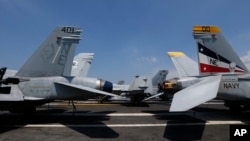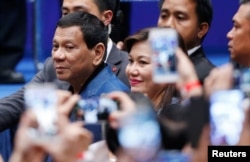Participation this year by Australia and Japan in annual U.S.-Philippine military exercises will raise pressure on China and could spark an escalation of military drills, experts say.
The U.S. Embassy in Manila said Thursday its Balikatan exercises with the Southeast Asian archipelago May 7-18 would bring in "multinational forces" from Australia and Japan for training as well as invite the United Kingdom as an observer. Australia has participated since 2014.
Australia, Japan and the United States have said they want to keep the 3.5 million-square-kilometer, resource-rich South China Sea open for international use. China calls more than 90 percent of the sea its own based on historic usage records.
Last week, the Chinese military website said a navy flotilla, including an aircraft carrier, “conducted a series of exercises” in the South China Sea.
The Philippine-hosted exercises could easily spark a new round of Chinese drills in the sea, said Oh Ei Sun, international studies instructor at Singapore Nanyang University.
“I think you are likely to see in the near future the frequency of such exercises would be increased, because on the one hand the Chinese I think (are) eager to, from their point of view, defend their claims in the South China Sea, while the U.S.- led coalition is equally firm in trying to exercise its freedom of navigation rights,” Oh said.
Escalation of exercises
The U.S.-Philippines exercises now in their 34th season avoided the South China Sea last year after President Rodrigo Duterte took office in Manila. Duterte has shelved a maritime sovereignty dispute with China over part of the sea to make friends with Beijing and secure investment deals.
This year’s exercises are slated to renovate five schools and do medical work in the Philippines, the U.S. Embassy said.
But the participation of multiple countries leery of China’s maritime expansion could spark another round of exercises by China, some warn.
Chinese forces challenged Australian ships approaching Vietnam, another maritime rival of Beijing, earlier in the month, Australian Broadcasting Corp. reported. China spars with Japan over sovereignty of tracts of the shared East China Sea, and the two see each other as economic rivals.
Over the past year, the United States, Japan and Australia have separately sent ships to the South China Sea, moves resented by China.
“Given that they've already developed their capabilities, it’s only natural to expect that they will keep exercising and keep honing their skills, and they'll do it probably in response to these external powers,” said Jay Batongbacal, University of the Philippines law and international maritime affairs professor.
Four-country alliance
Leaders from Australia, Japan, the United States and India – a group commonly known as the “quad” -- met in Manila in November to discuss keeping the South China Sea open to international use. Indian Prime Minister Narendra Modi told leaders from 10 Southeast Asian countries in January that his country was committed to working together more on maritime matters.
China has landfilled some of the sea’s 500 tiny islets, some for military installations. The other South China Sea claimants – Brunei, Malaysia, the Philippines, Taiwan and Vietnam – resent the Chinese expansion. Some have turned to outside powers, particularly Japan and the United States, for help such as arms sales.
The quad countries see an internationally open waterway as key to marine shipping, said Stuart Orr, professor of strategic management at Deakin University in Australia. About one-third of the world’s commercial shipping passes through it.
“All four countries are so heavily committed to trade based on transport through that sea, ensuring that it remains free is critical to economic performance,” Orr said.
Philippines in the background
The United States has offered the Philippines, a former colony, military protection since the 1940s and especially after the closure of the U.S. naval base at Subic Bay in 1992.
The Philippines may be letting the United States invite other countries to this year’s exercises as a “cat and mouse” approach to getting more aid from China, Oh said. China pledged $24 billion in aid and investment to the relatively impoverished Philippines in late 2016.
Overall the Philippines will keep “quiet” about the exercises next month and avoid becoming “too prominent” in light of upbeat ties under Duterte, Batongbacal said.
After the exercises, the Chinese foreign ministry will probably make a statement about its own maritime sovereignty claims and criticize the role of “external actors,” said Jonathan Spangler, director of the South China Sea Think Tank in Taipei. New military exercises are likely, but later, he said. Another round would lead to yet another response, he said.
“If China doesn't want other countries to be so involved militarily in the region then it probably also shouldn't be so ostentatious about its own military actions in the region,” Spangler said.








